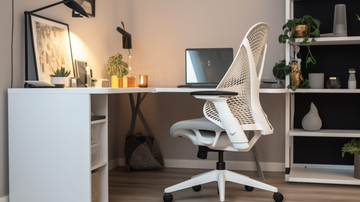An office chair is more than just a place to sit; it can significantly impact your comfort, productivity, and overall well-being during long hours at work. With countless options on the market, finding the perfect office chair can be a daunting task. In this comprehensive guide, we'll help you navigate the process of selecting an office chair that suits your unique needs, preferences, and workspace.
-
Understand the importance of ergonomics: Ergonomics is the study of designing workspaces, tools, and equipment to fit the user's needs and promote efficiency and well-being. When selecting an office chair, prioritize ergonomic features that encourage proper posture, minimize discomfort, and reduce the risk of injury.
-
Assess your workspace and budget: Before you begin shopping for an office chair, evaluate your workspace dimensions and budget. This will help you narrow down your search and focus on chairs that meet your specific requirements.
-
Consider the essential features: An ergonomic office chair should have the following essential features:
- Adjustable seat height: A pneumatic adjustment lever should allow you to easily raise or lower the seat to a comfortable height.
- Seat depth and width: Choose a chair with a seat that is wide and deep enough to accommodate your body comfortably.
- Lumbar support: Opt for a chair that provides adjustable lumbar support to help maintain the natural curve of your lower spine.
- Backrest: Look for a chair with an adjustable backrest in terms of height and angle to support your entire back.
- Armrests: Adjustable armrests that can be moved up or down, in or out, will help reduce strain on your shoulders and neck.
- Swivel and casters: A chair that swivels and has casters allows for easy movement and prevents strain from reaching for items on your desk.
- Explore additional features and customization options: While the essential features are a must, consider additional options that can further enhance comfort and personalization, such as:
- Seat material: Choose a chair with breathable, cushioned material that provides long-lasting comfort.
- Headrest: If you often experience neck strain, consider a chair with an adjustable headrest for added support.
- Advanced adjustability: Some chairs offer advanced adjustment options, like a synchro-tilt mechanism or seat slider, for enhanced ergonomics and customization.
- Aesthetic preferences: Consider the design, color, and materials of the chair to ensure it complements your workspace.
-
Test drive the chair: If possible, try out different office chairs in person. Sit down, adjust the chair to your body, and assess the overall comfort and support. Spend at least 10-15 minutes in each chair to get a true sense of how it feels during an extended period.
-
Read reviews and ask for recommendations: Online reviews and personal recommendations can provide valuable insights into the comfort, durability, and overall satisfaction of various office chairs. Read reviews from multiple sources and ask colleagues or friends about their favorite office chairs.
-
Don't forget the warranty and return policy: A good warranty and return policy can provide peace of mind and protect your investment. Look for chairs with at least a one-year warranty on parts and workmanship, and ensure you understand the return policy in case the chair doesn't meet your expectations.
Conclusion: Selecting the perfect office chair involves careful consideration of ergonomic features, workspace requirements, budget, and personal preferences. By following this comprehensive guide, you'll be well-equipped to choose an office chair that suits your needs and promotes comfort, productivity, and well-being in your workspace. Remember to prioritize ergonomics, test drive chairs when possible, and read reviews to make an informed decision. Happy chair hunting






